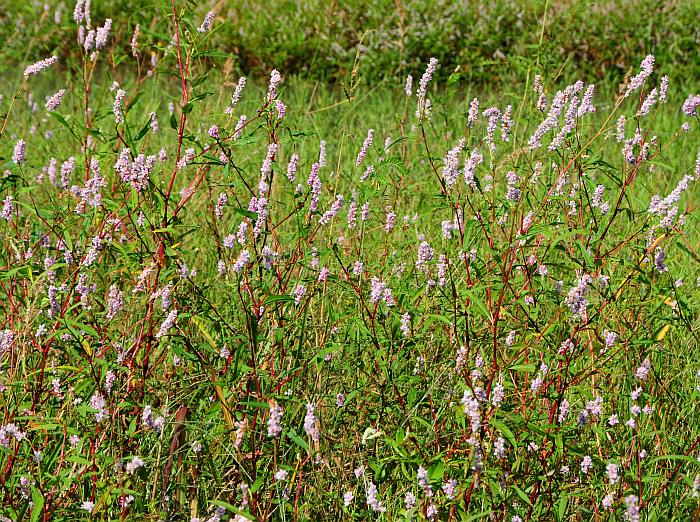Persicaria bicornis (Raf.) Nieuwl.
Pink Smartweed

Native
CC = 5
CW = -3
MOC = 12
© SRTurner
Persicaria bicornis (Raf.) Nieuwl.Pink Smartweed | |
 |
Native CC = 5 CW = -3 MOC = 12 |
© SRTurner |
|
Family - Polygonaceae Habit - Taprooted annual forb. Stem - Ascending to erect, to 1.8 m, sometimes from a spreading base, glabrous or appressed to spreading-hairy, most of the hairs usually gland-tipped. Ocreae persistent, usually tearing with age, 6-20 mm long, somewhat inflated toward the base, tan to white and papery throughout, the margin entire or nearly so, lacking bristles or occasionally with short, slender, extensions of the veins to 0.8 mm long, the surface glabrous or minutely roughened-hairy toward the base, not gland-dotted.
Leaves - Alternate, with petioles 0.1-2.2 cm long. Leaf blades 2-13 cm long, 1.0-2.5 cm wide, lanceolate, angled at the base, angled to a sharply pointed tip, the surfaces glabrous or appressed-hairy along the main veins, the undersurface with impressed glands, the upper surface sometimes with a reddish or purplish, chevron- to triangular-shaped area.
Inflorescences - Terminal and axillary from the upper nodes, usually several to numerous per main stem, 0.8-6 cm long, 10-18 mm wide, erect or ascending, dense, uninterrupted, the stalk 0.8-7.0 cm long, glabrous or hairy, the hairs usually gland-tipped. Ocreolae overlapping, the margins entire or with bristles 0.1-0.8 mm long, the surface usually glabrous, not gland-dotted. Flowers - Plants heterostylous, with flowers of some plants with the stamens exserted and those of others with the styles exserted. Flowers sometimes functionally pistillate or staminate, 2-11 per fascicle. Perianth light pink, bell-shaped, not gland-dotted, the tepals 5, 4-6 mm long, fused below the midpoint, the nerves relatively prominent but not anchor-shaped. Stamens 6-8, exserted or not, the anthers pink or red. Styles 2-branched from near the base, not or only slightly exserted, not persistent.
Fruits - 2-3 mm long, 2.0-2.8 mm wide, not or only slightly exserted, discoid or appearing slightly 3-angled, beakless, the faces flat to slightly convex, 1 of the faces usually with a central hump, the surface smooth, blackish brown to black, shiny. Flowering - July - October. Habitat - Swamps, pond margins, wet areas. Origin - Native to the U.S. Lookalikes - Persicaria pensylvanica, P. maculosa, P. glabra. Other info. - This species of smartweed is thought to be relatively uncommon in Missouri. Its known range in the U.S. includes a few centrally located states, extending as far southwest as Arizona. Photographs taken at Otter Slough Conservation Area, Stoddard County, MO, 9-10-2019 (SRTurner). |